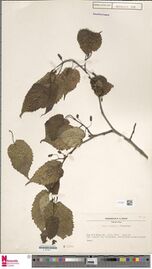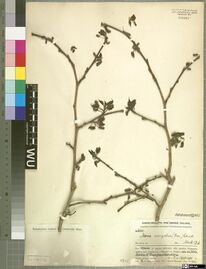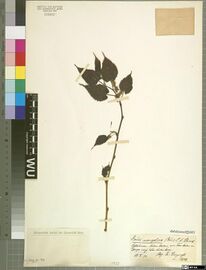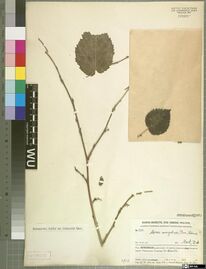Biology:Morus mongolica
| Morus mongolica | |
|---|---|
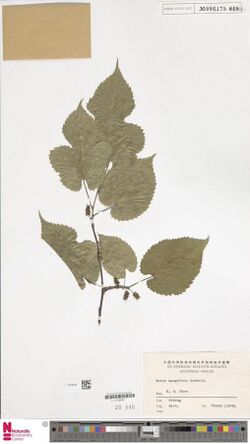
| |
| Scientific classification | |
| Kingdom: | Plantae |
| Clade: | Tracheophytes |
| Clade: | Angiosperms |
| Clade: | Eudicots |
| Clade: | Rosids |
| Order: | Rosales |
| Family: | Moraceae |
| Genus: | Morus |
| Species: | M. mongolica
|
| Binomial name | |
| Morus mongolica (Bureau) C.K.Schneid.
| |
| Synonyms | |
|
Morus alba var. mongolica Bureau | |
Morus mongolica,[1][2][3] also described as Morus alba var. mongolica,[4] is a woody plant native to mountain forests in Mongolia, China , Korea, and Japan .[1][5] Common names include Mongolian mulberry, meng sang (China ),[5] and ilama by native people in the namesake region of Mongolia.[6] Similar to M. notabilis, M. mongolica is an uncultivated (wild, undomesticated) mulberry.[7]
Description
Morus mongolica is a perennial woody tree. The mature plant grows to about 8 metres (26 feet) in height. The leaves of the tree are palmate, with mature dimensions ranging from 8–15 centimetres (3 1⁄4–6 inches) in length and 5–8 cm (2–3 1⁄4 in) in width.[5]
The flowers occur in inflorescences, both male and female.[1] The male inflorescences are about 3–4 cm (1 1⁄4–1 1⁄2 in) long and 7 millimetres (1⁄4 in) wide, whereas the female inflorescences are about 2 cm long and 7 mm wide; both have peduncles of about 1–1.5 cm.[1][5] Both the male and the female flowers are in groups of fours: four sepals, four petals, four stamen (for male flowers) and four carpels (for female flowers).[1] The tree blooms from March to April and fruits in April to May.[5]
The fruits are aggregate, and are dull red to black in color.[1] Each cluster is about 1–3 cm long with a 1 cm diameter, while the individual drupelets are about 3 mm in diameter.[1]
Chemistry
Morus mongolica is known to have multiple flavonoid and phenolic compounds.[8][9][10][11] These compounds can be found in the fruits,[10] leaves,[9] and bark.[12]
Distribution
Its native range is the mountains of Mongolia, China , Korea, and Japan .[1][5]
Ecology
The leaves are eaten and digested by silkworms[13] and the proteins are used by the silkworms for the production of cocoon silk.[7]
Uses
The fruits have been recorded as being consumed by Mongol herdsmen.[14]
The wood of the has been suggested to be of possible use for biofuel, among other soft wood trees.[15]
See also
- Morus (plant)
- Morus alba
- Flora of China
References
- ↑ 1.0 1.1 1.2 1.3 1.4 1.5 1.6 1.7 Sargent, Charles Sprague; Wilson, Ernest Henry (1913). Plantae Wilsonianae :an enumeration of the woody plants collected in western China for the Arnold arboretum of Harvard university during the years 1907, 1908, and 1910 /by E. H. Wilson, ed. by Charles Sprague Sargent.. Cambridge: The University press. doi:10.5962/bhl.title.191. https://www.biodiversitylibrary.org/bibliography/191.
- ↑ Zhekun, Zhou; Gilbert, Michael (2003). "Moraceae". Flora of China (Harvard University) 5: 21–73. http://flora.huh.harvard.edu/china/mss/volume05/Moraceae.pdf.
- ↑ USDA, Agricultural Research Service, National Plant Germplasm System.. "Morus mongolica (L.) C. K. Schneid.". https://npgsweb.ars-grin.gov/gringlobal/taxonomydetail.aspx?id=24617.
- ↑ USDA, Agricultural Research Service, National Plant Germplasm System.. "Morus alba (L.) var. mongolica Bureau.". https://npgsweb.ars-grin.gov/gringlobal/taxonomydetail.aspx?id=405221.
- ↑ 5.0 5.1 5.2 5.3 5.4 5.5 "Morus mongolica in Flora of China @ efloras.org". http://www.efloras.org/florataxon.aspx?flora_id=2&taxon_id=200006382.
- ↑ Soyolt; Galsannorbu; Yongping; Wunenbayar; Liu, Guohou; Khasbagan (2013-04-24). "Wild plant folk nomenclature of the Mongol herdsmen in the Arhorchin national nature reserve, Inner Mongolia, PR China". Journal of Ethnobiology and Ethnomedicine 9: 30. doi:10.1186/1746-4269-9-30. ISSN 1746-4269. PMID 23628479.
- ↑ 7.0 7.1 Li, Q. L.; Guo, J. Z.; Yan, N.; Li, C. C. (2016-10-17). "Complete chloroplast genome sequence of cultivated Morus L. species". Genetics and Molecular Research 15 (4). doi:10.4238/gmr15048906. ISSN 1676-5680. PMID 27813600.
- ↑ Sohn, H. Y.; Son, K. H.; Kwon, C. S.; Kwon, G. S.; Kang, S. S. (November 2004). "Antimicrobial and cytotoxic activity of 18 prenylated flavonoids isolated from medicinal plants: Morus alba L., Morus mongolica Schneider, Broussnetia papyrifera (L.) Vent, Sophora flavescens Ait and Echinosophora koreensis Nakai". Phytomedicine 11 (7–8): 666–672. doi:10.1016/j.phymed.2003.09.005. ISSN 0944-7113. PMID 15636183.
- ↑ 9.0 9.1 Zhang, Xiao-Qi; Jing, Ying; Wang, Guo-Cai; Wang, Ying; Zhao, Hui-Nan; Ye, Wen-Cai (October 2010). "Four new flavonoids from the leaves of Morus mongolica". Fitoterapia 81 (7): 813–815. doi:10.1016/j.fitote.2010.04.010. ISSN 0367-326X. PMID 20450963.
- ↑ 10.0 10.1 Chen, Hu; Yu, Wansha; Chen, Guo; Meng, Shuai; Xiang, Zhonghuai; He, Ningjia (December 21, 2017). "Antinociceptive and Antibacterial Properties of Anthocyanins and Flavonols from Fruits of Black and Non-Black Mulberries". Molecules 23 (1): 4. January 2018. doi:10.3390/molecules23010004. ISSN 1420-3049. PMID 29267231.
- ↑ Huang, Lian; Fuchino, Hiroyuki; Kawahara, Nobuo; Narukawa, Yuji; Hada, Noriyasu; Kiuchi, Fumiyuki (October 2016). "Application of a new method, orthogonal projection to latent structure (OPLS) combined with principal component analysis (PCA), to screening of prostaglandin E2 production inhibitory flavonoids in Scutellaria Root". Journal of Natural Medicines 70 (4): 731–739. doi:10.1007/s11418-016-1004-2. ISSN 1340-3443. PMID 27164908.
- ↑ Shi, Ya-Qin; Fukai, Toshio; Sakagami, Hiroshi; Chang, Wen-Jin; Yang, Pei-Quan; Wang, Feng-Peng; Nomura, Taro (February 2001). "Cytotoxic Flavonoids with Isoprenoid Groups from Morus mongolica". Journal of Natural Products 64 (2): 181–188. doi:10.1021/np000317c. ISSN 0163-3864. PMID 11429996.
- ↑ Niemelä, Pekka; Tuomi, Juha (1987). "Does the Leaf Morphology of Some Plants Mimic Caterpillar Damage?". Oikos 50 (2): 256–257. doi:10.2307/3566009. ISSN 0030-1299.
- ↑ Khasbagan; Huai, Hu-Yin; Pei, Sheng-Ji (2000). "Wild Plants in the Diet of Arhorchin Mongol Herdsmen in Inner Mongolia". Economic Botany 54 (4): 528–536. doi:10.1007/BF02866550. ISSN 0013-0001.
- ↑ Seth, M. K. (2003). "Trees and Their Economic Importance". Botanical Review 69 (4): 321–376. doi:10.1663/0006-8101(2004)069[0321:TATEI2.0.CO;2]. ISSN 0006-8101.
Further reading
- https://species.wikimedia.org/wiki/Morus_mongolica
- http://www.theplantlist.org/tpl/record/tro-50064861
- Zeng, Qiwei; Chen, Hongyu; Zhang, Chao; Han, Minjing; Li, Tian; Qi, Xiwu; Xiang, Zhonghuai; He, Ningjia (2015-08-12). Xu, Changjie. ed. "Definition of Eight Mulberry Species in the Genus Morus by Internal Transcribed Spacer-Based Phylogeny". PLOS ONE 10 (8): e0135411. doi:10.1371/journal.pone.0135411. ISSN 1932-6203. PMID 26266951. Bibcode: 2015PLoSO..1035411Z.
- Nepal, Madhav (2012). "Phylogenetics of Morus (Moraceae) Inferred from ITS and TRNL-TRNF Sequence Data". Systematic Botany 37 (2). doi:10.1600/036364412X635485. http://krex.k-state.edu/dspace/bitstream/2097/14013/1/Phylogenetics%20-%20publisher%27s%20PDF.pdf.
Wikidata ☰ {{{from}}} entry
 |
